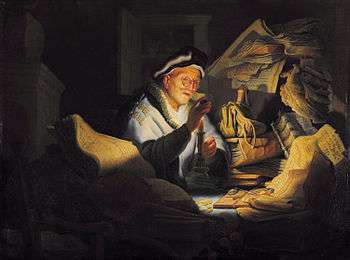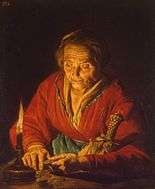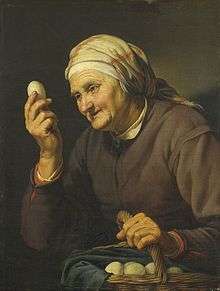The Parable of the Rich Fool (Rembrandt)
The Parable of the Rich Fool, also known as The Money Changer,[1] is an oil painting on canvas of 1627 by Rembrandt, now in the Gemäldegalerie, Berlin. Produced early in the artist's career, it depicts the eponymous Biblical parable. The model for the figure is said to have been Rembrandt's father.[1]

Related works
 Gerrit van Honthorst's Old Woman Studying a Coin, 1623–1624, a possible inspiration for the work
Gerrit van Honthorst's Old Woman Studying a Coin, 1623–1624, a possible inspiration for the work Matthias Stom's Old Woman by Candlelight, 1630–1640, with many similar elements
Matthias Stom's Old Woman by Candlelight, 1630–1640, with many similar elements Hendrick Bloemaert's, Woman Selling Eggs, 1632, a comparable composition
Hendrick Bloemaert's, Woman Selling Eggs, 1632, a comparable composition
gollark: It might be fun to use Codex to make that AI shell thing someone had.
gollark: They might struggle to write *idiomatic* Haskell.
gollark: I sort of know it, or at least can write reasonably working code in it even if I don't have an intuitive grasp of the weird underlying category theory stuff, but it's really annoying to do the sort of things my code usually involves in it. It's great for stuff like compilers and complex algorithms at least.
gollark: Haskell is very useful if you need to comonadize a zygohistomorphic prepromorphism.
gollark: Something about "explore-exploit tradeoffs".
References
- Wallace, Robert (1968). The World of Rembrandt: 1606–1669. New York: Time-Life Books. p. 38.
- (in Dutch) Gary Schwartz, Rembrandt, zijn leven, zijn schilderijen, Atrium, Alphen a/d Rijn, 1984.
External links
This article is issued from Wikipedia. The text is licensed under Creative Commons - Attribution - Sharealike. Additional terms may apply for the media files.